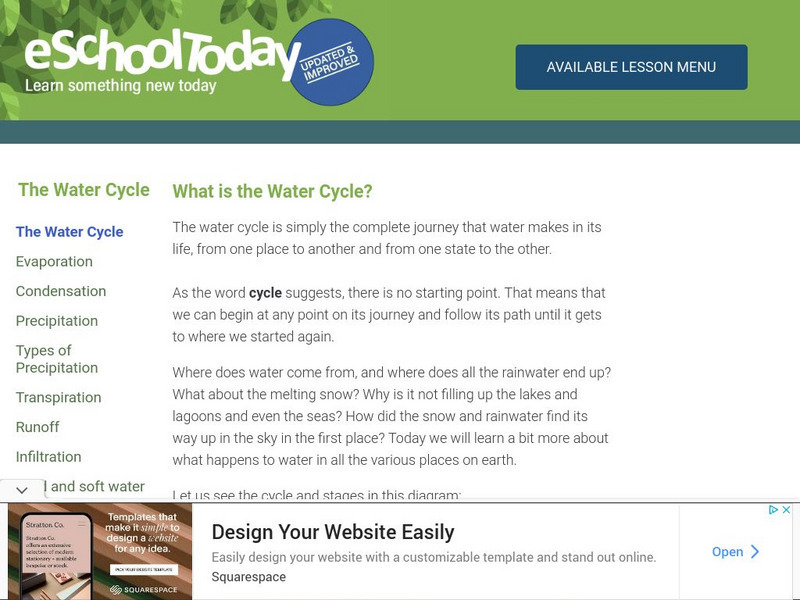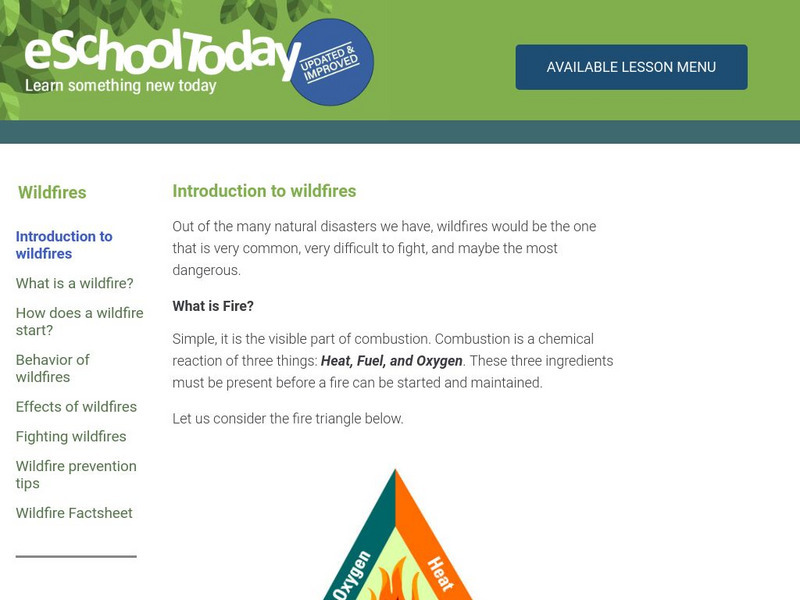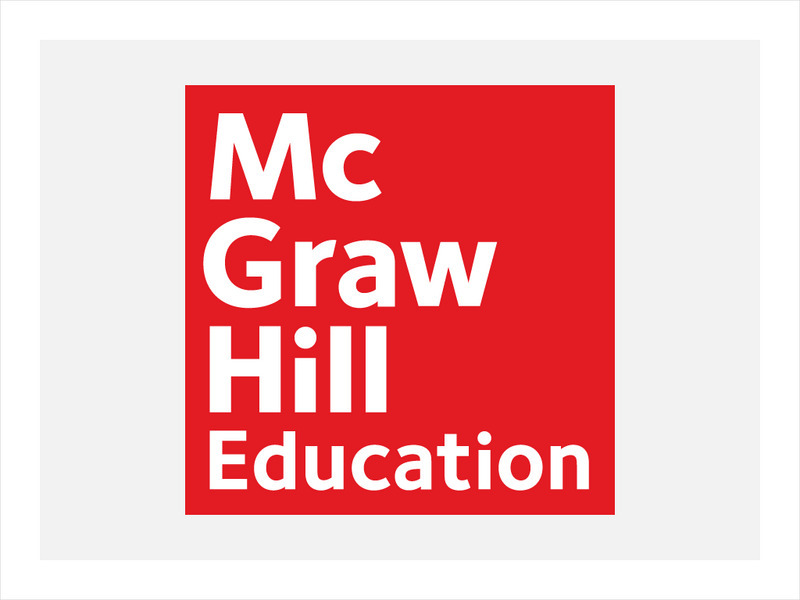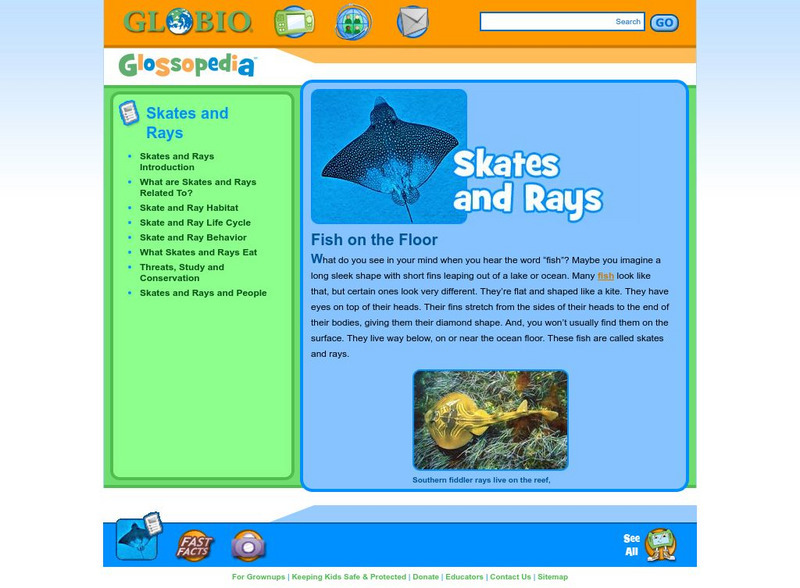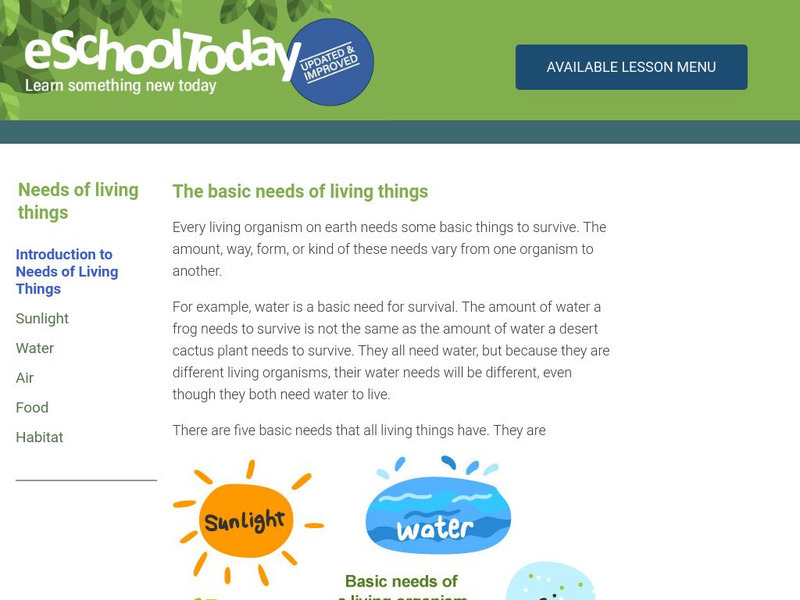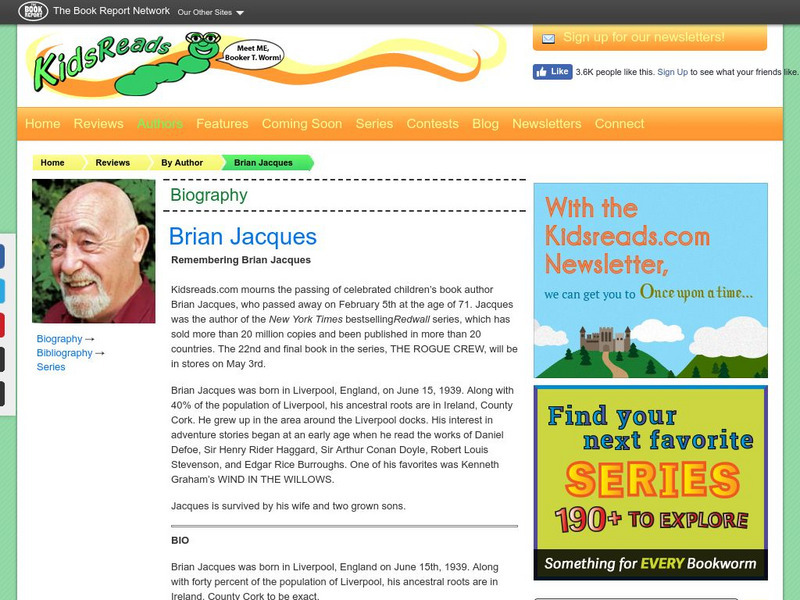eSchool Today
E School Today: Your Revision Notes on Rocks
Covers the three main types of rocks, different weathering processes, erosion, and the rock cycle.
eSchool Today
E School Today: Your Revision Notes on the Water Cycle
Learn about the different stages of the Earth's water cycle, and about processes involving water, including runoff, infiltration, and the differences between hard and soft water.
eSchool Today
E School Today: Your Revision Notes on the Nutrients in Food
Discusses food, why we need it, and the types of nutrients that food for humans must have.
eSchool Today
E School Today: Your Cool Basics on Natural Resources
Looks at the two categories of natural resources, what they are used for, their distribution around the world, threats to natural resources, recycling and composting, and conservation.
eSchool Today
E School Today: Your Cool Facts and Tips on Wildfires
Explains what a wildfire is, what causes them, how they behave, their impact, how to fight them, and how to prevent them.
eSchool Today
E School Today: Oral Care Tips for Great Teeth & Great Smiles
Learn about milk and adult teeth, the types of teeth we have and their functions, the anatomy of a tooth, dental decay and tooth plaque, how to take care of your teeth, what dental braces do, what causes bad breath or halitosis, and why...
McGraw Hill
Glencoe: Self Check Chapter Test Using Proportional Reasoning
The mathematics resource consists of an assessment with hints and solutions. Students answer questions that review proportional reasoning.
Utah Education Network
Uen: Enlightening Explorations, Part Ii
This lesson engages students in learning about light. Studets will describe how light is produced, reflected, refracted, and separated.
Globio
Glossopedia: Stars
Many of the objects you can see in the night sky are stars, large objects in space that produce light. Our galaxy, the Milky Way, contains more than 100 billion stars. Stars are so far away that their light does not reach us for years....
Globio
Glossopedia: Skates and Rays
There are more than five hundred different species of skates and rays in our oceans. Scientists say that these fish are closely related to sharks, sharing a common ancestor from around 400 million years ago. This article provides an...
Globio
Glossopedia: Chocolate
Chocolate begins as a seed of the tropical cacao tree. It has been a prized taste sensation for more than 2,500 years. One reason chocolate is so nice to eat is that it melts just below body temperature. So it really does melt in your...
Curated OER
National Park Service: The Invention Factory:thomas Edison's Laboratories
This Teaching With Historic Places lesson plan about Thomas Edison's laboratories is filled with maps, readings, critical thinking questions, and photographs related to Edison's labs and inventions. This site explains and details the...
PBS
Pbs Learning Media: The Columbian Exchange
In this interactive lesson supporting literacy skills, students watch video dramatizations that tell the story of the Spanish explorers who arrived in the Americas with Columbus and introduced European, African, and Asian plants and...
Exploratorium
Exploratorium: Bubbularium
What colors do you see in a bubble? Why do you see colors in a bubble? Use this site to find out the answer to these questions with this easy experiment.
Exploratorium
Exploratorium: Outrageous Ooze
Students can make ooze and learn about different qualifications of matter. An easy procedure is provided to make gooey ooze that you can play with when you are done.
Exploratorium
Exploratorium: Salt Volcano
By making oil float on water--with the help of other ingredients--students can create a lava-lite effect.
Exploratorium
Exploratorium: Hoopster
Students create their own airplane using straws and other materials and learn the principles of aerodynamics.
Library of Congress
Loc: Everyday Mysteries: Why Do Bats Live in Caves?
Ever wonder why bats live in caves? Or why bats don't fly into objects at night? This article describe why bats thrive in the protected shelter a cave provides. It also explains how bats use echolocation to locate food and avoid obstacles.
eSchool Today
E School Today: Your Revision Notes on the Needs of Living Things
Learn about the five things that all living things need to survive and why they are critical for both plants and animals.
eSchool Today
E School Today: Your Revision Notes on the Characteristics of Living Things
Discusses the five characteristics that living things have and nonliving things do not.
University of Florida
Baldwin Library: Abridged History of the United States
A scanned copy of the 1852 publication of Abridged History of the United States by Emma Willard, a nonfiction book for children.
University of Florida
Baldwin Library: The Desert Home
A scanned copy of the 1852 publication of The Desert Home by Mayne Reid, a fiction book for children.
The Book Report
Kids reads.com: Brian Jacques
This site gives you a biography of Brian Jacques as well as an interview with him about his writing.
Homeschool Math
Homeschool Math: Triangles
This lesson plan provides students with an opportunity to practice drawing and measuring triangles and angles. It also shows pictures and gives definitions of each type of angle and triangle.



